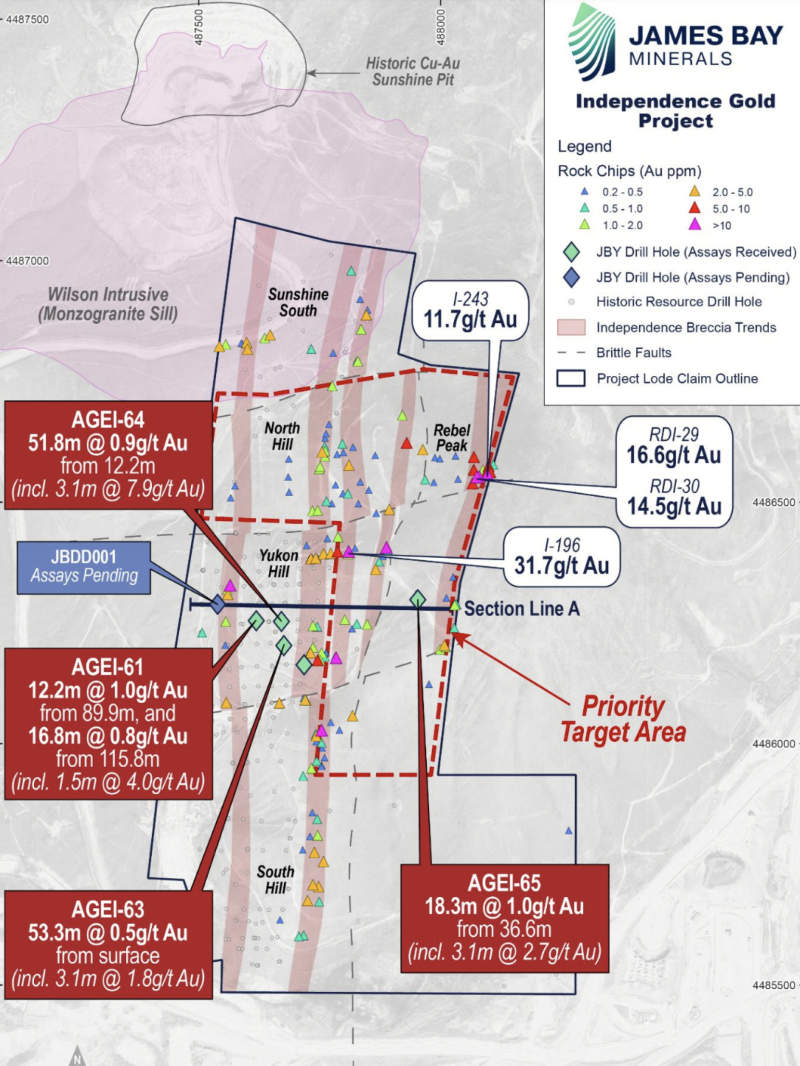Independence bounty grows as James Bay drilling returns thick gold intercepts

James Bay Minerals’ Phase 1 drilling at the Independence project has returned wide intersections of gold outside the current non-JORC resource. Pic: Getty Images
- JBY drilling returns wide intersections of gold outside the current non-JORC resource at Independence
- Notable assays include a top hit of 1.5m at 9.4g/t gold and an 18.3m at 1g/t hit at Rebel Peak
- Planning underway for the next phase of drilling
Special Report: James Bay Minerals’ first drilling at its Independence project in Lander County, Nevada, has yielded wide gold intercepts that included a peak assay of 1.5m grading 9.4g/t gold.
The five reverse circulation holes in the Phase 1 program confirmed that additional gold mineralisation is present outside of the current non-JORC resource after returning assay results such as 18.3m at 1g/t gold from a down-hole depth of 36.6m (AGEI-65).
Notably, AGEI-65 is the first hole to test mineralisation at Rebel Peak in the project’s east and represents a 520m updip test of historical drill intersections.
Four of the five holes drilled by James Bay Minerals (ASX:JBY) targeted intrusion-related breccias and returned results such as 51.8m at 0.9g/t gold from 12.2m including 3.1m at 7.9g/t (that further hosts the peak assay) in hole AGEI-64.
The drill results follow on systematic rock chip sampling indicating that from-surface ore-grade gold mineralisation spans the project with 77 samples returning assays above 1g/t gold and a peak result of 31.7g/t.
Rock chip sampling also provided further evidence of from-surface oxide gold mineralisation at the untested North Hill and Sunshine South areas.
“Phase 1 drill results at the Independence project are extremely promising, with assays up to 9.4g/t Au and confirmation of a 520m up-dip extension,” executive director Andrew Dornan said.
“The eastern hole, AGEI-65, drilled under a 1.1g/t Au rock sample (IDD-19) on an existing road, returned grades more than double the current near-surface mineral resource.
“This highlights the exciting potential for future drilling beneath high-grade rock samples grading up to 16.6g/t Au (RDI-29) on Rebel Peak, 300m along strike of AGEI-65, setting the stage for significant growth in 2025.”

Drill results
JBY noted that historical drilling at the Independence project had focused on the near-surface high-level epithermal mineralisation across the southern half of the project spanning the Yukon and South hills.
Recent rock chip sampling found that previously unrecognised high-grade mineralisation was present in the Rebel Peak area in the project’s east after returning assays of 16.6g/t gold, 14.5g/t and 11.7g/t.
Hole AGEI-65 was positioned proximal to a cluster of rock chip samples with a peak value of 1.1g/t gold on an already-cleared road that is 300m along strike to the south of Rebel Peak to test for mineralisation outside the current non-JORC NI43-101 resource of 1.18Moz gold and 7.6Moz silver.
The other holes targeted gaps within the resource within structures adjacent to intrusive dykes.
JBY noted that while the thick intercepts of gold within the chert were typically lower grade than the structurally-hosted mineralisation at the project, they are amenable to heap leach extraction – a low-cost method that is widely utilised across Nevada’s epithermal deposits.
Planning is currently underway for the next phase of drilling, which will target oxide mineralisation extensions in the northern half of Independence and the untested Rebel Peak mineralised trend.
Logging and sampling of available historical diamond drill core is ongoing with IND-03 at the laboratory for gold and multi-element analysis.
Once complete, this work will enable the company to plan future diamond drill campaigns targeting polymetallic mineralisation within the Pumpernickel Formation as well as deeper gold-silver skarn mineralisation within the Battle Formation.
This article was developed in collaboration with James Bay Minerals, a Stockhead advertiser at the time of publishing.
This article does not constitute financial product advice. You should consider obtaining independent advice before making any financial decisions.
Related Topics

UNLOCK INSIGHTS
Discover the untold stories of emerging ASX stocks.
Daily news and expert analysis, it's free to subscribe.
By proceeding, you confirm you understand that we handle personal information in accordance with our Privacy Policy.








